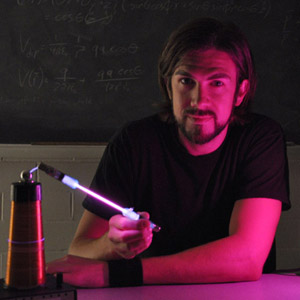Student Profile - Nick Lanning
Math and physics major Lanning reflects on research
As a dual major in physics and mathematics, Nick Lanning of Orange has reached far beyond textbooks through research opportunities offered at Lamar University. His work with Lamar’s Ronald E. McNair Post-Baccalaureate Achievement and STAIRSTEP programs have offered Lanning invaluable research experience and even earned him national recognition.
His work with Lamar’s Ronald E. McNair Post-Baccalaureate Achievement and STAIRSTEP programs have offered Lanning invaluable research experience and even earned him national recognition.
The American Physical Society at its annual meeting in Boston this year honored Lanning among the APS Society of Physics Students with the Award for Outstanding Poster Presentation in March. Focusing on physics research from industry, universities and major labs, the APS annual meeting is the largest physics meeting in the world.
“It was quite an honor to receive an award at such a large event among so many presenters from schools all over the world,” Lanning said. His presentation, “Formation of wave packets in electron diffraction on crystals,” discusses electron diffraction patterns and how they can reveal the atomic structures of crystals.
Lanning’s presentation is based on the STAIRSTEP research topic he began in 2009, the program’s first year at Lamar. Sponsored by the National Science Foundation, STAIRSTEP is designed to help students graduate college and advance into the professional Science, Technology, Engineering and Mathematics (STEM) fields by helping students develop skills as researchers in their chosen fields.
“I had only taken an introductory physics course when I joined STAIRSTEP. The other members of our research group were juniors and seniors with a lot more experience. Brainstorming with the group was a challenge at first since all the topics were very new to me,” said Lanning. “It really motivated me and helped me to learn faster.”
Interestingly enough, STAIRSTEP launched during Lanning’s second semester back at Lamar after a six-year hiatus. When he first enrolled at Lamar as a freshman in 1999, Lanning said, he had no idea what career he wanted to pursue. While he had always been interested in pursuing STEM fields, Lanning lacked confidence in his potential and felt unprepared for the challenging curriculum he faced. He left Lamar in 2002 to enroll at Lamar Institute of Technology where he earned an associate’s degree in business management.
Meanwhile, Lanning’s position as a window tinter at Classic Tint in Beaumont proved to be a profitable alternative.
“I enjoyed the trade because there was always a challenge to get a little better or work a little faster. You have to have a lot of patience to be a window tinter,” Lanning said. While his business degree from LIT opened new opportunities for Lanning in the tint industry, he found himself longing to pursue his original interest in physics. He returned to Lamar in 2008, where he was greeted by his first daunting challenge: calculus.
Upon the advice of his advisor, Lanning re-took his math prerequisites that summer before taking calculus in the fall. Lanning’s calculus professor’s seminar method challenged him to work and think independently.
“I tore through the class notes like my life depended on it, and I wound up doing great in the class,” Lanning said. His professor recognized Lanning’s triumph in calculus and encouraged him to pursue a math degree in addition to his physics degree. Thankfully, Lanning found that his dual curricula supported one another.
“I’ve been very fortunate that my physics classes always seemed to pair up well with something we were covering in my math classes, like when I took advanced linear algebra at the same time I took quantum mechanics,” he said. “Quantum mechanics is bizarre just with the fundamental principles and their implications, but it’s also when you see a lot of crazy linear algebra for the first time.”
In Spring 2011, Lanning was accepted into the McNair program, a federal program for first-generation college students and members of groups generally underrepresented in graduate education. Designed to prepare undergraduate students for doctoral studies through research and other scholarly activities, the program prompted Lanning to once again pursue a research topic of his choice. Using a precise method developed by his McNair mentor, Cristian Bahrim, Lanning’s research examined the dispersive properties of dielectric materials such as glass prisms. Lanning added a twist by incorporating an additional light source to actually change the dispersive properties.
“Studying physics and mathematics at Lamar gave me that sense of purpose that I had been searching for, and my next challenge is to develop a career as a researcher and fulfill that purpose in my life,” said Lanning, who graduated in May. “I feel very blessed to have been mentored by such great professors and to have been met with all the opportunities that have enhanced my time at Lamar,”
Currently in the process of applying for graduate schools, Lanning seems to have an interesting connection to light. From blocking light as a window tinter, to manipulating light so as to puzzle prisms, and most recently, receiving national recognition for his study of the light diffraction process itself, Lanning has certainly earned some time for reflection.

